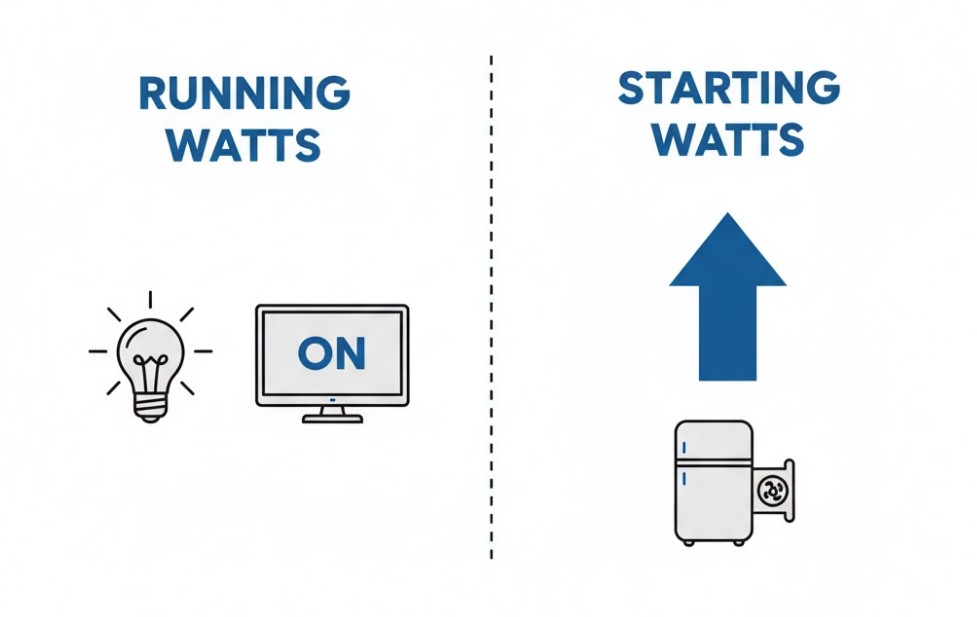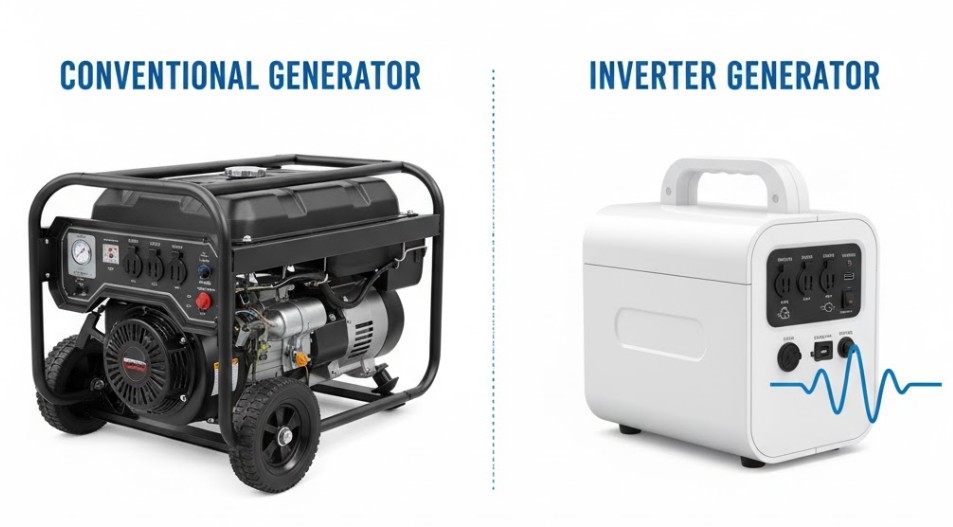A power outage can bring life to a standstill, whether you’re at home, on a job site, or enjoying an RV trip. The solution? A reliable generator. However, choosing the right unit isn’t as simple as picking the largest one available. The key to efficiency, longevity, and affordability lies in accurate sizing, which is where a robust generator wattage calculator methodology becomes indispensable. Selecting a unit that’s too small will leave essential appliances unpowered, while one that’s too large wastes fuel and money.
This comprehensive guide will walk you through the precise steps to calculate your power needs, helping you move from uncertainty to confidently choosing the perfectly sized generator for your specific requirements. We’ll demystify the crucial difference between running wattage and starting wattage, ensuring you never come up short when you need power the most.
Why Proper Generator Sizing Matters
Before diving into the numbers, it’s vital to understand the stakes. The size of your generator dictates its performance and cost of ownership. Getting it right offers several significant benefits:
- Efficiency: A properly sized generator operates efficiently, consuming less fuel and lasting longer. An oversized generator often “lugs” or runs at low capacity, leading to poor fuel economy and potentially causing carbon buildup.
- Appliance Safety: Generators must supply a stable electrical load. Overloading a generator or undersizing it can cause voltage fluctuations, potentially damaging sensitive electronics like computers, refrigerators, or medical equipment.
- Cost Savings: Generators are a substantial investment. Purchasing only the power you need saves on the initial purchase price and reduces ongoing maintenance and fuel costs.
The Core Concept: Running vs. Starting Wattage
The foundation of any effective generator wattage calculator is a clear understanding of the two primary types of power demand: running wattage and starting wattage.

Running Wattage (Rated Watts)
The running wattage, also known as rated watts or continuous watts, is the power an appliance needs to run steadily once it’s on. This is the continuous, stable power output that the generator must be able to sustain for the duration of the outage. For most non-motorized appliances—like lights, televisions, and heating elements—the running wattage is the only figure you need to worry about.
Starting Wattage (Surge Watts)
Appliances with electric motors—such as refrigerators, air conditioners, well pumps, and freezers—require a burst of extra power, often called surge wattage, for a fraction of a second when they first start up. This momentary power spike is called starting wattage. This surge is necessary to overcome the initial inertia and resistance of the motor. It is critical to calculate this because your generator must be capable of handling this brief, high demand.
For more detailed information on this critical topic, review the difference between running and surge starting wattage here.
Step-by-Step Generator Wattage Calculator Methodology
To accurately find the right size generator, you must go through a three-step process. Treat this as your personal generator wattage calculator workflow:
Step 1: Identify and List All Essential Appliances
The first step is a thorough inventory. Walk through your home, RV, or job site and decide exactly which items you must run simultaneously during a power outage. Be realistic; you likely won’t need to run every single device at once.
Pro Tip: Create different priority lists. For a short outage (4-8 hours), you might only power the refrigerator and a few lights. For an extended outage (days), you’ll add the furnace fan, water pump, and perhaps a small window AC unit.
Common Household Items and Estimated Wattage:
| Appliance | Running Watts (Approx.) | Starting Watts (Approx.) |
|---|---|---|
| Refrigerator (16 cu ft) | 700 | 2200 |
| Central A/C (10,000 BTU) | 1500 | 4500 |
| Sump Pump (1/3 HP) | 800 | 1300 |
| Microwave (1000W) | 1000 | N/A |
| 100W Incandescent Light Bulb | 100 | N/A |
| Furnace Fan (1/3 HP) | 700 | 1400 |
| Coffee Maker | 1200 | N/A |
Note: Appliance wattage can vary significantly. Always try to find the nameplate or sticker on your specific appliance, as these numbers are the most accurate. If you can only find amperage (Amps), you can convert it using the formula: Watts = Volts x Amps (assuming a standard 120V or 240V). If the appliance only lists horsepower (HP), you can use the approximation that $1 \text{ HP} \approx 746 \text{ Watts}$.
Step 2: Calculate the Total Running Wattage (Baseline)
Now, sum up the running wattage for every single item on your essential list. This gives you the baseline continuous power the generator must supply. This is the minimum required running wattage for your generator.
Example Calculation:
- Refrigerator: 700W
- Furnace Fan: 700W
- 10 Lights (100W each): 1000W
- Television/Computer: 300W
- Total Running Watts: $700 + 700 + 1000 + 300 = 2700 \text{ Watts}$
Step 3: Determine the Maximum Starting Wattage Requirement (The Surge)
This is the most crucial part of the generator wattage calculator process. Your generator needs to supply the Total Running Wattage PLUS the highest single Starting Wattage of any motor on your list.
Do not add all starting wattages together. Appliance motors typically cycle on and off at different times. The generator only needs to handle the surge from the single largest motor attempting to start while all other items are already running.
In the example above, let’s identify the highest starting wattage item:
- Refrigerator Starting Watts: 2200W (Highest Surge Item)
- Furnace Fan Starting Watts: 1400W
The calculation for the required Generator Starting Watts (Surge Watts) is:
$$ \text{Generator Starting Watts} = \text{Total Running Watts} + \text{Highest Single Starting Wattage} $$
$$ \text{Generator Starting Watts} = 2700 \text{W (Total Running)} + 2200 \text{W (Refrigerator Surge)} = 4900 \text{ Watts} $$
This result, 4900 Watts, is the minimum peak power your generator must be able to produce for a brief period to successfully start the refrigerator while everything else is running.
Selecting the Right Generator Type and Capacity
With your 4900W starting requirement and 2700W running requirement in hand, you are now equipped to choose the perfect unit. Generator manufacturers clearly list two ratings: the Rated Wattage (Running) and the Maximum/Surge Wattage (Starting).
You would look for a generator that has a Running Wattage of at least 2700W and a Starting Wattage of at least 4900W. A model rated at 3,000 Running Watts / 5,000 Starting Watts would be an excellent fit.
Conventional Portable vs. Inverter Generators
Your choice of generator type can also impact the required size, especially when powering sensitive electronics.
- Conventional Portable Generators: These are robust and cost-effective, offering high power output, making them ideal for high-demand applications like construction sites or backup power for large appliances.
- Inverter Generators: These units produce cleaner, stable sine wave power, which is much safer for sensitive electronics like laptops, smart TVs, and medical devices. They are also quieter and more fuel-efficient, often making them the preferred choice for RVs, camping, and smaller home backup needs. Many modern inverters can also be run in parallel to double their output, a great way to scale power without buying a single massive unit.

Accounting for Future Needs and Safety Margin
It is always wise to add a 20% safety margin to your final calculated Total Running Watts. Power needs can change, and appliances can draw more power as they age. In our example, the 2700W running requirement would be better served with a generator capable of $2700 \text{W} \times 1.20 = 3240 \text{W}$ of continuous power. This small buffer provides peace of mind and prevents the generator from operating constantly at its absolute limit.
For those looking for the ultimate in reliability and convenience, consider exploring whole-house generator options, which are professionally installed and automatically power your entire home when an outage occurs. You can read more about them here.
Common Mistakes When Using a Generator Wattage Calculator
Even with the right formula, people often make mistakes that lead to an undersized or improperly functioning system:
- Ignoring Starting Wattage: The single most common error. If you only account for running watts, your generator will stall, trip its breaker, or fail to start the largest motor.
- Simultaneous Starting Assumption: Assuming every motorized appliance will start at the exact same moment. This is highly unlikely in a typical home scenario, which is why you only use the highest single starting wattage.
- Underestimating Well Pump/HVAC: These appliances are often 240V and have very high starting loads. They can easily require 4,000-8,000 starting watts on their own, severely impacting your total calculation.
- Voltage Confusion: Mixing up 120V and 240V appliances. Always confirm the voltage of high-demand items like electric ranges, central AC, and well pumps.
Final Thoughts
Choosing the correct generator size doesn’t have to be a confusing ordeal. By following this generator wattage calculator methodology—meticulously listing your essential items, distinguishing between running wattage and starting wattage, and applying a sensible 20% safety margin—you can confidently purchase a unit that perfectly matches your needs.
A properly sized generator provides not just power, but peace of mind, ensuring that when the grid goes down, your essential operations—be it keeping the food cold, the lights on, or the tools running—can continue without interruption.
Amranul is a highly experienced product review writer with a passion for helping readers make smart, informed purchasing decisions. Since 2018, he has specialized in thoroughly researching and analyzing a wide range of products to deliver honest, in-depth reviews. Amranul combines technical accuracy with clear, engaging writing to break down complex product features and highlight true user value. Look for his reviews to find reliable information and expert insights you can trust before you buy!



![5 Best Radiator Case Fans for Liquid Cooling 2025 [140mm] 9 Best Radiator Case Fans for Liquid Cooling 2019 [140mm]](https://bestreviews.vip/wp-content/uploads/2019/06/Best-Radiator-Case-Fans-for-Liquid-Cooling-2019-140mm-150x150.jpg)

